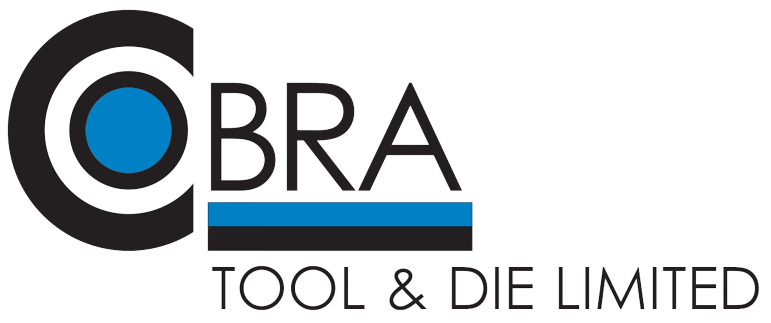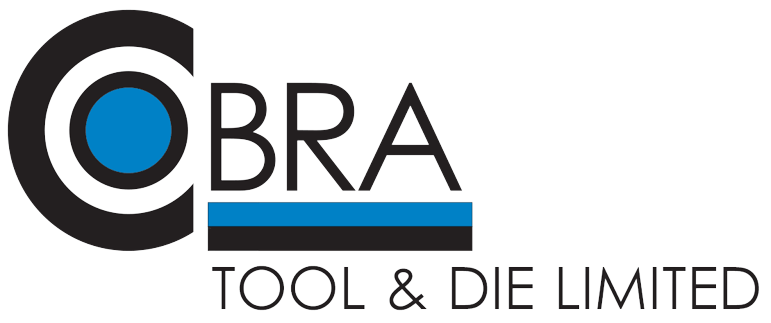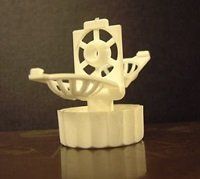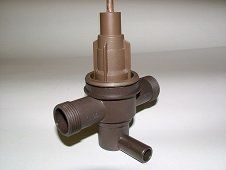Injection Mould Tool Production
expert toolmakers
As UK-based precision engineers, Cobra Tool & Die have the capacity to handle part or all of the production process for injection mould tools on-site.
Each stage of your project can be managed in-house at our premises in Portsmouth, from product development, product design and prototype tooling to production tooling, servicing and rapid repairs.
Mould Tools for Plastic Injection Tool Mouldings have always been the backbone of our business. As expert toolmakers with decades of experience, our knowledge and expertise is second to none and is highly regarded by our customers.
Why Choose Our Mould Tool Production?
Reliability, Accuracy, & Precision
Over the years the tools produced by us have given our customers many years of accurate, precise and reliable use.
They’re Built To Last
Using the best components from the outset, our tools are built to last.
We’re Expert Toolmakers
We have decades of experience, knowledge and expertise in toolmaking. We also offer a rapid refurbishment service to ensure that downtime is kept to a minimum as and when required.
INJECTION MOULD TOOLING FAQs
Some frequently asked questions about injection mould tool production
-
What services does Cobra Tool & Die offer for injection mould tool production?
We offer a complete range of precision engineering services in-house.
Injection mould tool production is a core part of our business. A range of machinery for CNC milling, wire erosion and spark erosion (EDM) is used to produce injection mould tooling.
Many of the industries we serve operate to strict standards, and therefore precision and finish are essential in order to maintain the integrity and performance of components.
We run a small, flexible toolroom with highly skilled toolmakers and machinists on hand to deliver top-quality solutions for our clients.
-
What industries do you serve?
We serve a diverse and ever-changing range of industries.
The range of applications for injection moulding is so extensive because of the many advantages it offers.
In the UK, injection moulding is the most widely used method for manufacturing plastic components, offering efficiency and precision.
For production at scale, cost per unit is kept low. At the same time, the process of injection moulding is also suitable for producing detailed and complex components.
Cobra Tool & Die produces injection mould tools for automotive parts, electronic components, medical and pharmaceutical components, ophthalmic instruments, aerospace, plastics and rubber moulders, and more.
-
Do you offer rapid repair and tool refurbishment services?
Yes, our Rapid Repair service is a complete solution for repair, refurbishment and maintenance of injection mould tools.
Our transport service connects us with clients and partners around the UK.
You can contact us in order to arrange collection and delivery to minimise downtime and maximise efficiency.
-
What design and production technology do you use?
Injection mould tools must be manufactured to high quality and precision standards and must also be durable in order to produce high volumes of parts. They have to be robust and built to last.
Cobra Tool & Die utilise a full design CAD package and a full CNC machining package with an array of high-performance CNC machines to deliver the highest standards in tooling.
-
Can you help with product design and development for injection mould tools?
Yes, we can offer bespoke product design from concept to completion, including 3D printing for prototypes and R&D. All stages of the process can be handled on-site, from concept to fully hardened production tooling.
We can work with your own design or offer the support of our in-house design team who are also based at our premises in Farlington, Portsmouth, UK.
For bespoke product design for injection mould tools, contact us to discuss your project and requirements.
-
How long does it take to produce an injection mould tool?
The production time for an injection mould tool can be from around 2 to 10 weeks depending on the complexity and the volume involved.
Generally, projects with shorter lead times include rubber moulds and prototypes.
For a more complex project, contact us to discuss your requirements.
-
What are the advantages of having a director-level contact for injection mould tool production?
Accountability and Communication
Having a director-level contact means that your project receives personal attention at all stages of the tool manufacturing process. Direct communication channels ensure a clear understanding of your requirements and adherence to key deadlines for delivery of your finished injection mould tooling. You can call us or visit in person.
Experience and Expertise at the highest levels
Director involvement also brings a wealth of experience and expertise to injection mould tool production, however simple or complex it may be. You can discuss all aspects of your project over the phone, via email or in person.
Efficient Decision Making
Having direct communication with our tool room means that decisions are made quickly and with your input. Any delays are reduced or avoided altogether, and your project progresses smoothly and efficiently.
-
What are the advantages of working with a UK-based company for injection mould tools?
Proximity and Location
As well as facilitating easier communication, working with a local UK toolmaking company provides the advantage of proximity and shorter lead times. In case any adjustments or modifications are required at any stage of the process, these can be managed on-site.
Because all stages of tool design and manufacturing are handled in-house, there are no unnecessary transport delays, keeping your project on schedule.
Quality Production
As a UK injection moulding manufacturer, Cobra adheres to stringent standards and regulations, ensuring that the injection mould tools produced are of the highest quality. This is crucial for industries like automotive and healthcare, where quality cannot be compromised.
You can read more about our high production standards here.
Built to Last
Mould tools produced in-house are overseen by us at all stages of production to ensure optimum performance and longevity. They are designed and manufactured to deliver many years of productivity.
-
How often does an injection mould tool need maintenance?
When it comes to injection mould tool maintenance, a regular servicing schedule is always recommended to ensure optimum performance and productivity.
Maintenance is usually done during regular servicing of the injection mould tool. We generally recommend servicing regular tools every three months, or every 50000 cycles.
A recommended maintenance schedule for the injection mould tool involves regular inspection, cleaning, and repair to ensure the optimal performance and longevity of the tool. This process includes checking for wear and tear on critical parts like cavities, cores, and ejector pins. Injection mould tool maintenance could involve lubricating moving components, removing residue, and checking that channels are free from blockages. Any damage, such as cracks or deformations, must be repaired promptly to prevent defects in components and keep your operations running optimally.
For quick and efficient tool maintenance and repair, we stock many grades of hardened steel, which we offer clients to repair broken/worn inserts.
Collection and delivery can be arranged to bring you a door-to-door service.
-
What are the uses of injection mould tools in the UK automotive sector?
The UK automotive sector uses injection mould tooling to produce components of all sizes, from dashboards and bumpers to complex smaller parts.
Because of the high level of precision it offers, as well as the durability of the finished tooling, injection moulding enables manufacturers to meet production criteria consistently and at scale.
-
How is injection moulding used in motorsport?
When it comes to motorsport, performance, reliability and safety are crucial, and on top of this, our industry partners are often working to extremely tight schedules.
A racing team, for example, might rely on quick production and delivery of an injection mould tool or component for testing new setups, so partnering with a well-connected UK precision engineering company delivers a competitive edge.
PARTS OF THE INJECTION MOULD TOOL
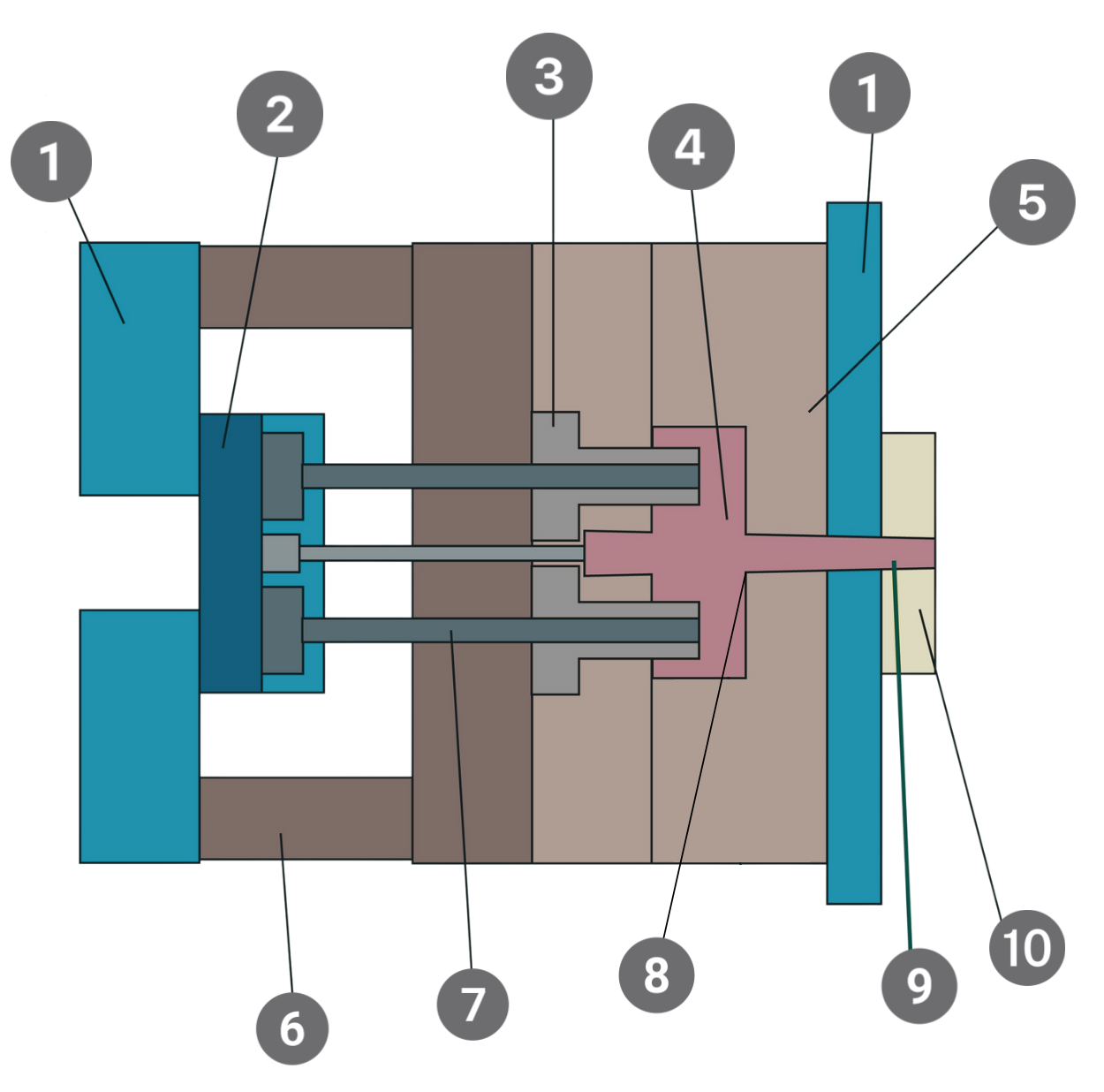
The diagram shows a section through the centre of a basic injection mould tool.
1. Back plate (fixed half / moving half)
The back plate is a mounting surface for the components of the injection mould, attaching the mould to the injection moulding machine. The mould halves need to come together accurately during the injection moulding process, so the back plate serves to provide stability, aligning the halves correctly.
2. Ejector plate
The role of the ejector plate is to support the ejector pins (see point 9) and to move them forward to eject the product from the injection mould tool once it has solidified.
3. Core
The core makes up the internal shape of the product and is part of the lower half of the mould tool. It works together with the cavity to define the final shape of the product during plastic injection moulding. If there are internal features or hollow parts of the product, the core is the part of the mould tool that forms these.
4. Product
The product is the final component that is produced by the injection moulding process. The product can be a small, intricate part or a larger, complex component; products manufactured from moulds produced at Cobra Tool & Die range from high-spec seals and gaskets to consumer goods.
5. Cavity
The cavity is the hollow part of the injection mould that shapes the product. The upper half of the mould forms the cavity, which is where the molten plastic is injected. The cavity of the plastic injection mould must be designed and finished to a high standard in order to produce high-quality components.
6. Spacer block
This maintains the required distance between mould plates during the plastic injection moulding process. The mould must close uniformly, with all parts correctly aligned.
7. Ejector pin
The ejector pin pushes out the product from the injection mould once it is solid.
8. Runner
A pathway that directs the molten plastic from the sprue into the cavity, designed to balance the flow.
9. Sprue or feed
Molten plastic enters the mould via the sprue, also known as the feed. This is the channel that connects the injection moulding machine nozzle to the runner system. The flow rate and pressure of the injected material is affected by the design of the sprue itself.
10. Location ring
The location ring locates the tool in the press. This makes sure that the mould is positioned correctly and aligned with the nozzle of the injection moulding machine.
Contact Us
If you would like to discuss your toolmaking needs, whether that’s innovation, concept design, new tooling or repairs, get in touch with us to find out more about what we can offer you. Give us a call, or why not pop in and see us!
All Rights Reserved | Cobra Tool & Die Ltd
